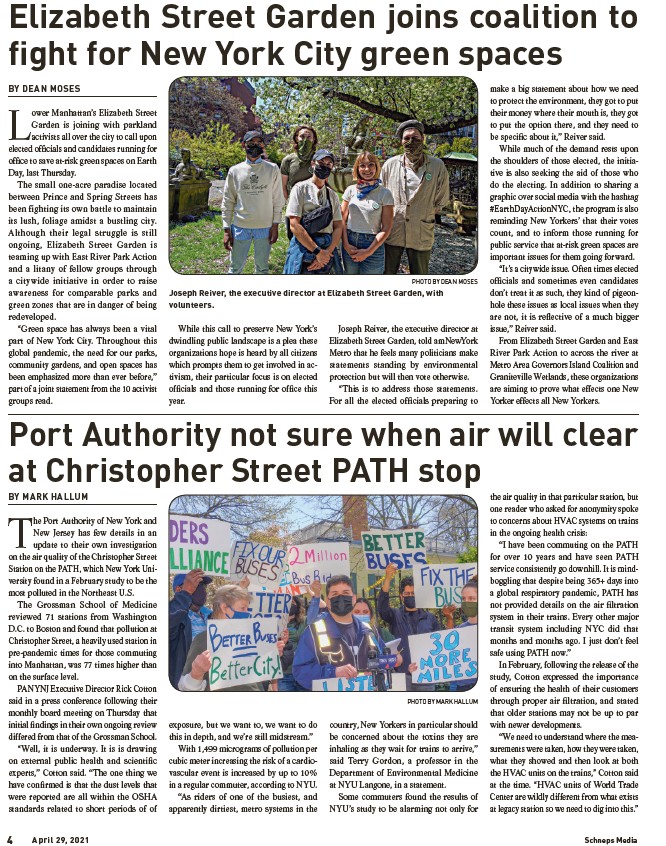
Elizabeth Street Garden joins coalition to
fi ght for New York City green spaces
BY DEAN MOSES
Lower Manhattan’s Elizabeth Street
Garden is joining with parkland
activists all over the city to call upon
elected offi cials and candidates running for
offi ce to save at-risk green spaces on Earth
Day, last Thursday.
The small one-acre paradise located
between Prince and Spring Streets has
been fighting its own battle to maintain
its lush, foliage amidst a bustling city.
Although their legal struggle is still
ongoing, Elizabeth Street Garden is
teaming up with East River Park Action
and a litany of fellow groups through
a citywide initiative in order to raise
awareness for comparable parks and
green zones that are in danger of being
redeveloped.
“Green space has always been a vital
part of New York City. Throughout this
global pandemic, the need for our parks,
community gardens, and open spaces has
been emphasized more than ever before,”
part of a joint statement from the 10 activist
groups read.
Joseph Reiver, the executive director at Elizabeth Street Garden, with
volunteers.
While this call to preserve New York’s
dwindling public landscape is a plea these
organizations hope is heard by all citizens
which prompts them to get involved in activism,
their particular focus is on elected
offi cials and those running for offi ce this
year.
PHOTO BY DEAN MOSES
Joseph Reiver, the executive director at
Elizabeth Street Garden, told amNewYork
Metro that he feels many politicians make
statements standing by environmental
protection but will then vote otherwise.
“This is to address those statements.
For all the elected offi cials preparing to
make a big statement about how we need
to protect the environment, they got to put
their money where their mouth is, they got
to put the option there, and they need to
be specifi c about it,” Reiver said.
While much of the demand rests upon
the shoulders of those elected, the initiative
is also seeking the aid of those who
do the electing. In addition to sharing a
graphic over social media with the hashtag
#EarthDayActionNYC, the program is also
reminding New Yorkers’ that their votes
count, and to inform those running for
public service that at-risk green spaces are
important issues for them going forward.
“It’s a citywide issue. Often times elected
offi cials and sometimes even candidates
don’t treat it as such, they kind of pigeonhole
these issues as local issues when they
are not, it is refl ective of a much bigger
issue,” Reiver said.
From Elizabeth Street Garden and East
River Park Action to across the river at
Metro Area Governors Island Coalition and
Graniteville Wetlands, these organizations
are aiming to prove what effects one New
Yorker effects all New Yorkers.
Port Authority not sure when air will clear
at Christopher Street PATH stop
BY MARK HALLUM
The Port Authority of New York and
New Jersey has few details in an
update to their own investigation
on the air quality of the Christopher Street
Station on the PATH, which New York University
found in a February study to be the
most polluted in the Northeast U.S.
The Grossman School of Medicine
reviewed 71 stations from Washington
D.C. to Boston and found that pollution at
Christopher Street, a heavily used station in
pre-pandemic times for those commuting
into Manhattan, was 77 times higher than
on the surface level.
PANYNJ Executive Director Rick Cotton
said in a press conference following their
monthly board meeting on Thursday that
initial fi ndings in their own ongoing review
differed from that of the Grossman School.
“Well, it is underway. It is is drawing
on external public health and scientifi c
experts,” Cotton said. “The one thing we
have confi rmed is that the dust levels that
were reported are all within the OSHA
standards related to short periods of of
exposure, but we want to, we want to do
this in depth, and we’re still midstream.”
With 1,499 micrograms of pollution per
cubic meter increasing the risk of a cardiovascular
event is increased by up to 10%
in a regular commuter, according to NYU.
“As riders of one of the busiest, and
apparently dirtiest, metro systems in the
PHOTO BY MARK HALLUM
country, New Yorkers in particular should
be concerned about the toxins they are
inhaling as they wait for trains to arrive,”
said Terry Gordon, a professor in the
Department of Environmental Medicine
at NYU Langone, in a statement.
Some commuters found the results of
NYU’s study to be alarming not only for
the air quality in that particular station, but
one reader who asked for anonymity spoke
to concerns about HVAC systems on trains
in the ongoing health crisis:
“I have been commuting on the PATH
for over 10 years and have seen PATH
service consistently go downhill. It is mindboggling
that despite being 365+ days into
a global respiratory pandemic, PATH has
not provided details on the air fi ltration
system in their trains. Every other major
transit system including NYC did that
months and months ago. I just don’t feel
safe using PATH now.”
In February, following the release of the
study, Cotton expressed the importance
of ensuring the health of their customers
through proper air fi ltration, and stated
that older stations may not be up to par
with newer developments.
“We need to understand where the measurements
were taken, how they were taken,
what they showed and then look at both
the HVAC units on the trains,” Cotton said
at the time. “HVAC units of World Trade
Center are wildly different from what exists
at legacy station so we need to dig into this.”
4 April 29, 2021 Schneps Media